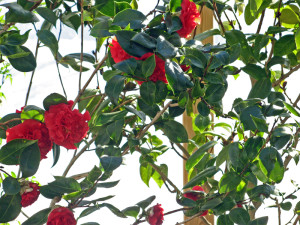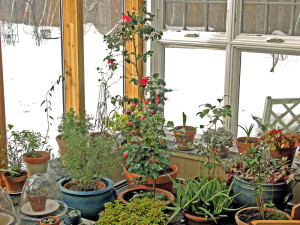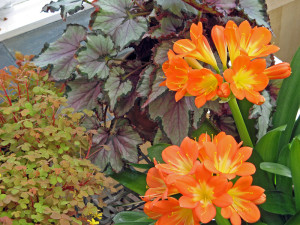A Green Room
Our greenhouse is much more than a collection of pretty plants. It is a magical space where, even in the depths of winter, we retreat to be immersed in the soothing presence of growing things.
Surrounded by four walls and full of greenery, it is a green room in the truest sense of the term.
A room for people and plants

At dead of winter Camellia japonica puts on its show
Our green room is designed to be congenial for both people and plants. As such it meets two very different sets of needs:
People needs: an aesthetically pleasing living space where one can read a good book, sit and chat, or comfortably minister to the needs of the plants.
Plants needs: appropriate amounts of light, water and nutrients in a frost-free and predominately pest-free environment.
Dick and I started our Vermont lives with an all-glass aluminum-framed greenhouse and, over time, discovered it leaked heat like a sieve.
So in 2009 we bit the bullet, and decided to replace it with a new, wood-framed, more heat retentive structure, while utilizing the old foundation wall.
A northcountry greenhouse
And for this we turned to Dennis Bates of Vermont Sun Structures. His beautifully hand-crafted structures are a pleasure to behold, and we were attracted to his unique design, optimized for our latitude, that maximizes winter heat efficiency while minimizing summer heat build-up. Unlike a conventional greenhouse with an all-glass roof, Dennis uses glass in just the lower half of the roof.
In the winter months the sun is low in the sky and, even with a half-glass roof, sunlight reaches all the way to the north wall of our greenhouse. This captures the maximum light, which is good for winter plant growth and provides desirable solar heating.
By contrast, in summer the sun is much higher in the sky, and the solid portion of the roof shades the entire back half of the greenhouse, which reduces unwanted solar heating.
Orientation matters
The long front wall and angled roof of our greenhouse face due south, which is the ideal orientation to make the most of the weak winter sun. And indeed on sunny days, even when the temperature outside is down around -10°F, the temperature inside the greenhouse will climb a very comfortable 70°F, making it the perfect space for reading the newspaper or sipping tea.
Spatial design
Designing a indoor garden room is not so different from designing a multi-use outdoor garden space, like a patio or an entrance garden.
Consider both form and function.
Our greenhouse measures just 18 feet long and 10 feet deep. Space is at a premium and we share very close quarters with our plants.

A medley of plants in the southwest corner
So when it comes to spatial lay-out, every inch counts, and it is really helpful to use a scale drawing that shows how everything will relate to everything else on the ground.
In the early days with our old greenhouse I must confess to a strictly rectilinear layout. Then one day it hit me. This was neither visually attractive, nor was it particularly efficient.
So, like any garden designer, I grabbed a piece of paper and drew up a base plan of the whole space, showing everything that was immutable. Then, just as with an outdoor design, I set about experimenting with concept sketches to find a layout that would be both functional and aesthetically pleasing.
I was delighted with the resulting design which I immediately implemented in the old greenhouse. Then, since the new greenhouse used the identical dimensions, it made perfect sense to carry over most of the basic design too.
The design starts with the people spaces:
the entrance: a pair of sliding glass doors in the left half of the rear (north) wall
a sitting space: two chairs and a small table along the right half of the rear wall
the floor: pavers set in a herringbone pattern that permits drainage
a workspace: a small potting table and shelves above, in the northwest corner
a curved path: unencumbered floor space linking the door and the sitting space
an exit to the outside: a glass door set into the east wall.
The remaining floorspace, including the entire south wall as well as the southeast and southwest corners, is for plants. Smaller plants sit on a low plant table along the center of the south wall and, in winter, on a plant stand covering the door to the outside; while larger plants in their pots sit directly on the floor.
This arrangement had plenty of advantages:
The sitting space is sized for two chairs and a small table
People look out through the plants to the snowy world outside
The plant space is nicely sunny and the southeast and southwest corners can accommodate several good sized shrubs in pots.
Light and shade in the greenhouse
All plants need some light, but some need less than others.
In the world outdoors, trees reach up to the sun and, in so doing they cast a dappled shade on the ground below. And this is where you find plants that prefer a shady lifestyle. Many of these, like the Darmera which I grow in my outdoor garden, have evolved outsize leaves to catch enough rays for their photosynthetic needs.

In the shade of a Camellia, an orange Clivia shows off beside a purple-leaved Rex Begonia and yellow Oxalis
In my indoor garden I follow this natural order. First I positioned the tall shrubby camellias in large, hard-to-move pots, in the southeast and southwest corners of the greenhouse. The gentle shade on the floor below is a perfect spot for plants like Clivia, Oxalis and Rex Begonias that are prone to sunburn.
I can recall a huge planting of Clivia thriving under the trees in Golden gate Park in San Francisco. And this is the setting that I have replicated in miniature in my greenhouse.
Pots for greenhouse versatility
In the old greenhouse many of my plants lived together in a long raised bed along the entire south wall. But I found that this very static arrangement was not at all satisfactory, and in our new greenhouse almost every plant lives in its own pot. Here is why:

A large specimen Begonia set in a hand-thrown clay pot in dappled shade
The indoor garden benefits immensely from gorgeous containers. So my prized hand-thrown clay pots get to spend summers outdoors and their winters in the greenhouse. In the picture on the right I have set a large specimen begonia, still in its terracotta pot (with packing peanuts underneath for added height) inside an elegant creamy-colored container.
One of life's small pleasures is being able to group plants together for aesthetic effect. See how, in the picture above, the Clivia's orange blooms stand out in front of a purple-leaved Rex Begonia and a yellow Oxalis.
It is extremely desirable to be able to re-position plants in response to seasonal light changes.
Despite the best planning, in a communal bed some plants eventually outgrow their welcome.
A bug-infested plant can be quickly banished for treatment.